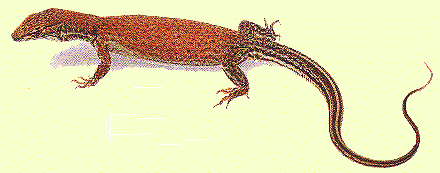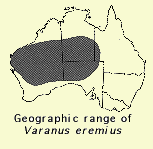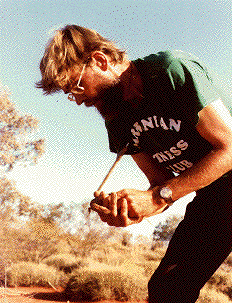 Varanus eremius My favorite lizard, the pygmy monitor lizard Varanus eremius, like myself, hunts lizards. Varanus eremius are common in Australian sandy deserts, judging from the frequency of their unique and conspicuous tracks. Unlike larger goannas, they are active all year long. However, this beautiful little red Varanus is extremely wary and very seldom seen. Nevertheless, a great deal about its activities can be inferred from its tracks. 
Sands constitute a natural event recorder, leaving a record of what creatures have moved past. Strong winds regularly dull and erase all tracks. Although it took quite a while, I eventually became fairly skilled at reading the record in the sand. Tracks are difficult to see during mid-day when the sun is high or on overcast days. Morning and afternoon are prime times for tracking when the sun is low in the sky and shadows are long. Tracks are best seen by looking into the light. After a bit of experience, one begins to be able to judge the "run" of the track, that is where the animal is headed. It is almost like becoming the lizard yourself. This allows one to move ahead quickly, cutting the track at intervals, to find the lizard rapidly. You can even tell the approximate age of a track by its crispness and whether or not other tracks, say those of nocturnal species, cross over the track in question. Nothing is much more exciting than finding a crisp new track less than an hour old, for you know that the maker of that track is close by at the end of the track. It is like finding a line guaranteed to lead you to a neat lizard! On a very hot trail I always walk as quietly as possible, barely breathing, scouting ahead to look for the lizard itself. Tracking large lizards across sandy areas has become one of my favorite pastimes. You can learn a great deal about wary unobservable species such as Varanus in this way. It is an incredible thrill when the track suddenly becomes the magnificent animal, captured in mid-stride and frozen in time. More often than not, however, before you see it, the animal breaks into a run and dives down a hole or climbs up a tree and escapes into a hollow. The track of a running animal is often harder to follow than that of one walking. Statements about Varanus eremius to follow are based upon impressions I have gained while following literally hundreds of kilometers of eremius tracks on foot. Individuals usually cover great distances when foraging. I have often followed a fresh track for distances of up to a kilometer. Tracks indicate little tendency to stay within a delimited area; home ranges of these lizards would appear to be extremely large. These pygmy monitors are attracted to fresh holes and diggings of any sort, and will often visit any man-made digging within a few days after it is made. In contrast to V. gouldi, V. eremius do not dig for their prey, but rather rely upon catching it above ground. More than once, I have noted an eremius track intercept the track of another smaller lizard with evidence of an ensuing tussle. One such pair of tracks came together, rolled down the side of a sandridge leaving a trail of big and little tail lash marks, and finally become one track, dragging away a fat belly! One eremius, weighing 42.5 gm., had eaten a Ctenophorus inermis with a body mass of 12.2 ml (28.7 % of the eremius's body mass). Once, while stalking a small skink, my ex-wife Helen actually observed an eremius attack another lizard from ambush. On this occasion, a large eremius jumped out of a loose Triodia tussock when a small blue-tailed skink (Ctenotus calurus) came within a few centimeters of the edge of the tussock. Stomach contents reveal that over 76% of the eremius diet by volume consists of other lizards, whereas large grasshoppers plus an occasional large cockroach or scorpion constitute most of the remainder. Nearly any other lizard species small enough to be subdued is eaten (82 stomachs with food contained 53 individual lizard prey representing some 14 other species in addition to other items). Prey species eaten by eremius include the following skinks Ctenotus calurus, C. dux, C. grandis, C. leusueri, C. piankai, C. quatturodecimlineatus, C. schomburgkii, Lerista bipes, Menetia greyi, Morethia butleri,, the pygopodid Delma, the agamids Ctenophorus inermis, C. isolepis, and Gemmatophora longirostris. In a typical foraging run, an individual eremius often visits and goes down into several burrows belonging to other lizard species, especially the complex burrow systems of the nocturnal skink Egernia striata. These activities could be in search of prey, related to thermoregulatory activities, and/or simply involved with escape responses. Certainly an eremius remembers the exact positions of the burrows it has visited, since it almost inevitably runs directly to the nearest one when confronted with the emergency of a lizard collector. The smallest gravid female eremius had a SVL of 110 mm, whereas the smallest male with enlarged testes had an SVL of 116, suggesting that females may reach sexual maturity earlier than males. Mating occurs in the austral spring, during October- November. Eggs are laid during November-December and hatchlings emerge in mid January-early February. Hatchling snout-vent lengths range from 59-64 mm (weights from 1.9 to 3.3 grams). During the mid-70's, our Botany and Zoology graduate students in population biology founded an arcane club they called the "Darwinian Fitness Club." Customized green T-shirts were made up with the name of the club on the front  side, while that particular person's favorite study organism's scientific name (a latin binomial) was on the back side. On the eve of my departure for the deserts of Western Australia for a year's sabbatical as a Guggenheim Fellow, these graduate students held a going-away party and made me an honorary member of their club (the first faculty member to be so honored). They presented me with my own customized T-shirt sporting "Varanus eremius" on the back, which I wore with pride down under. Aussies puzzled over it, thinking that it was odd for someone rather out of shape to proclaim publically to be some kind of a physical fitness buff (of course, Darwinian fitness is simply relative reproductive success).
side, while that particular person's favorite study organism's scientific name (a latin binomial) was on the back side. On the eve of my departure for the deserts of Western Australia for a year's sabbatical as a Guggenheim Fellow, these graduate students held a going-away party and made me an honorary member of their club (the first faculty member to be so honored). They presented me with my own customized T-shirt sporting "Varanus eremius" on the back, which I wore with pride down under. Aussies puzzled over it, thinking that it was odd for someone rather out of shape to proclaim publically to be some kind of a physical fitness buff (of course, Darwinian fitness is simply relative reproductive success).
ERP gets bitten by his favorite lizard species References Pianka, E. R. 1968. Notes on the biology of Varanus eremius. Western Australian Naturalist 11: 39-44. Download pdf Pianka, E. R. 1982. Observations on the ecology of Varanus in the Great Victoria desert. Western Australian Naturalist 15: 37-44. Download pdf Pianka, E. R. 1986. Ecology and Natural History of Desert Lizards. Analyses of the Ecological Niche and Community Structure. Princeton University Press, Princeton, New Jersey. 208 pp. Pianka, E. R. 1994. Comparative ecology of Varanus in the Great Victoria desert. Australian Journal of Ecology 19: 395-408. Download pdf. Pianka, E. R. 2007. An update on the Ecology of the Pygmy Monitor Varanus eremius in Western Australia. Third multidisciplinary world conference on monitor lizards, Alexander Koenig Museum, Bonn, Germany. Mertensiella 16: 346-352. Download pdf To read about other species of Varanus, click Desert Varanus. Return to Pianka lab page |